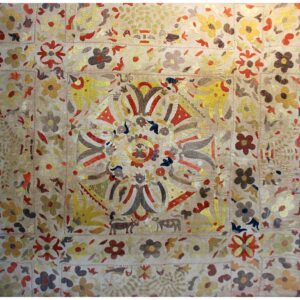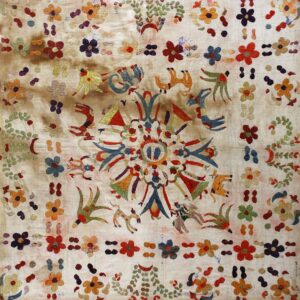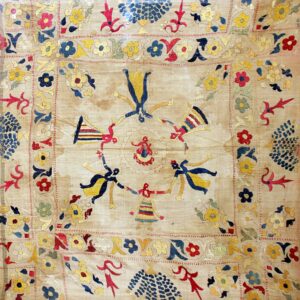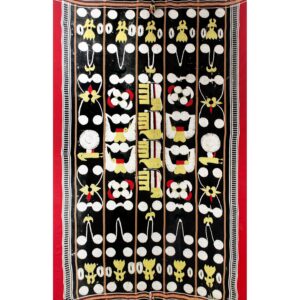The Chamba Rumal gets its name from Chamba, a hill-station in Himachal Pradesh, where it has been practiced for centuries. The region is known for its history, architecture and landscapes but the local community is also known for its arts and crafts, in particular the miniature Pahari paintings. The Pahari School of art has received royal patronage since the 17th century when it is believed to have originated in the region. The impeccable needlework on the Chamba Rumals too is derived from the art movement, combining miniature art with embroidery. Chamba Rumals are typically made in square or rectangular fabric of varying sizes. The base art, consisting of intricate lines, is traditionally drawn by miniature art experts. Once the art is complete, the embroidery—usually undertaken by women—is meticulously executed on the fabric. The materials used are naturally dyed silk floss on mal-mal or khaddar fabrics. A distinctive double-sided technique is seen in the designs. The motifs on these handkerchiefs have traditionally drawn from the Ramayana, Mahabharata, Bhagavad Purana, and the nature and life of the local community members. The earliest example of the embroidery incidentally can be found in Punjab — Bebe Nanki, sister of the Sikh spiritual leader Guru Nanak, reportedly embroidered one in the 16th century and the item was preserved in the state’s Hoshiarpur shrine. The tradition gradually made its way out of palace walls and began to be practised by local craft clusters. The Rumals came to be an integral part of weddings, exchanged by the bride and groom’s families as a sign of goodwill. Practiced actively until the early 20th century, declining patronage from royal quarters led to the art slowly dying in the second half of the decade making way for cheap and inauthentic imitations.


Chamba Roomal (handkerchief)
₹275,000.00
Dimension: 28.5X28.5 Inches
Medium: Embroidery
Additional information
| Weight | |
|---|---|
| Dimensions | 28.5X28.5 Inches |
| Medium | Embroidery |
| Provenance |




